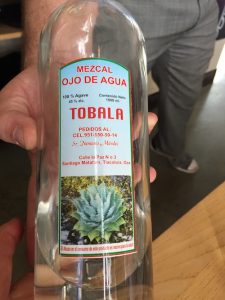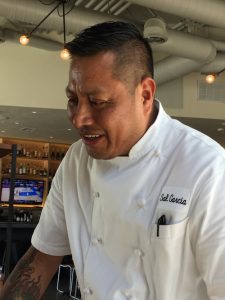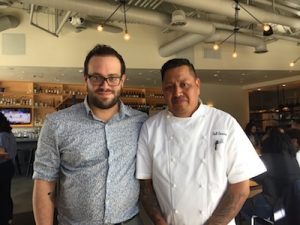Salud! Commerson’s Mezcal “alcohol actual querida” Menu
(Gerry Furth-Sides) Commerson is the sort of place where even the simplest of conversations lead to discoveries. One of them, on our first visit for brunch, was with Chef Garcia. A little bit shy at first, we learned that his hometown is Oaxaca, the “heart of mezcal” country (among the three most famous regional exports including hand-carved animals). Within minutes, he shared his treasured “Tobala” Mezcal Ojo de Agua with us. Tobala’s flavor differs from maguey Espadin (sword) or maguey Azul (blue). When manager Brandon Bernstein joined in, the conversation took a turn about the start of a Commerson mezcal bar program. This is major news at a time when even the finest Mexican restaurants often offer only one mezcal. See the new bar menu below. It especially interests anyone like me, who loves esoteric grappa, retsina and the “wilder” types of drinks despite the fact that is not harsh or rough.

Chef Sal Garcia shared his treasured “Tobala” Mezcal Ojo de Agua from his hometown in the “heart of mezcal” country.
Enthusiastic manager, Brandon, promised he would let us know when a shipment of special mezcals arrived. It arrived! Dedicated to creating a standout mezcal program, Brandon’s plan is to always stock 15 varietals, from entry level to advanced, with an informational booklet to go along with it. Mezcals from the states of San Luis Potosí and Guerrero and from Mazatlán in the state of Sinaloa will join those from the more familiar Oaxacan origin.
We were honored to try a few of the mezcals from the new menu, along with matching dishes. The mezcals ranged from $50 to $100 a bottle, which gives an idea of the quality.

Chef Sal Garcia shared his treasured “Tobala” Mezcal Ojo de Agua from his hometown in the “heart of mezcal” country.

Chef Sal Garcia shared his treasured “Tobala” Mezcal Ojo de Agua from his hometown in the “heart of mezcal” country.

Chef Sal Garcia shared his treasured “Tobala” Mezcal Ojo de Agua from his hometown in the “heart of mezcal” country.
Because lighter tepehuaje and sabino wood is used, Mezcal Metiche has a distinct, less smoky flavor. Metiche is also more rare because it is made from the wild Salmiana Agave that has to be cultivated in extremely dry climates. The plant has to be nearly 15 years old before it can be harvested. This mezcal is finished off in adobe ovens instead of clay earthen ovens, which influences it to be spicier than most. It has a vegetal flavor and scent.
Bozal is a treat not often found even in Spanish bars. The espadín agave, known as the genetic mother of the Blue Weber Agave, is used to produce tequila, and is also the predominant agave used in mezcal production. Espadin from San Luis Del Rio in Oaxaca, is traditionally made using a Chilean tahona (a stone mill) pulled by a horse to grind the agave. Unique in itself, the characteristics of this particular agave showcase the aromas of wet earth, a rich smokiness on the mid-palate, and a finish reminiscent of wild flowers.
Mezcal has become the darling of the tequila world, because growth and popularity has slowly been leading to the rise of quality and to high-end, premium mezcal being imported. According to the Distilled Spirits Council, sales of Mexico’s “other” agave-based spirit has grown from less than 50,000 cases a decade ago to more than 350,000 cases this year. Commerson is outstanding in its program, which rivals Mezcal Bars in the city.
But how is mezcal different from tequila? Tequila can only be made using blue weber agave grown in specific regions of the Mexican states of Jalisco and other bordering states including Guanajuato, Michoacán, Nayarit, and Tamaulipas. Mezcal, on the other hand, can be made with any agave grown in the Mexican states of Oaxaca, Durango, Guanajuato, Guerrero, San Luis Potosí, Tamaulipas, Zacatecas, Michoacan, and Puebla. And, like tequila, the designation, “mezcal,” once a reference to any spirit distilled from fermented agave, is now a product officially controlled by its denomination of origin. Fascinating fact: Although most mezcal is made using industrial tools and methods, much of it is also made using stone-lined earthen ovens, stone mills pulled by horses, open-air wooden fermenters and wood-fired copper pot stills.
For a more detailed version of how mezcal because the darling of the spirits world, please see //www.forbes.com/sites/richardnalley/2013/03/28/the-eye-mezcal-hold-the-worm/#59bc42eb78b2
Commerson Restaurant, with the quirky name of a French explorers, bookends one end of the the trendy, boutique-filled La Brea Street, and is on a corner near the Metro line. 788 S. La Brea Ave., Los Angeles, (323)813-3000.


















 Gerry Furth-Sides
Gerry Furth-Sides  Barbara Hansen
Barbara Hansen  Chef-owner Alain Cohen
Chef-owner Alain Cohen  Roberta Deen
Roberta Deen  Jose Martinez
Jose Martinez  Nivedita Basu
Nivedita Basu